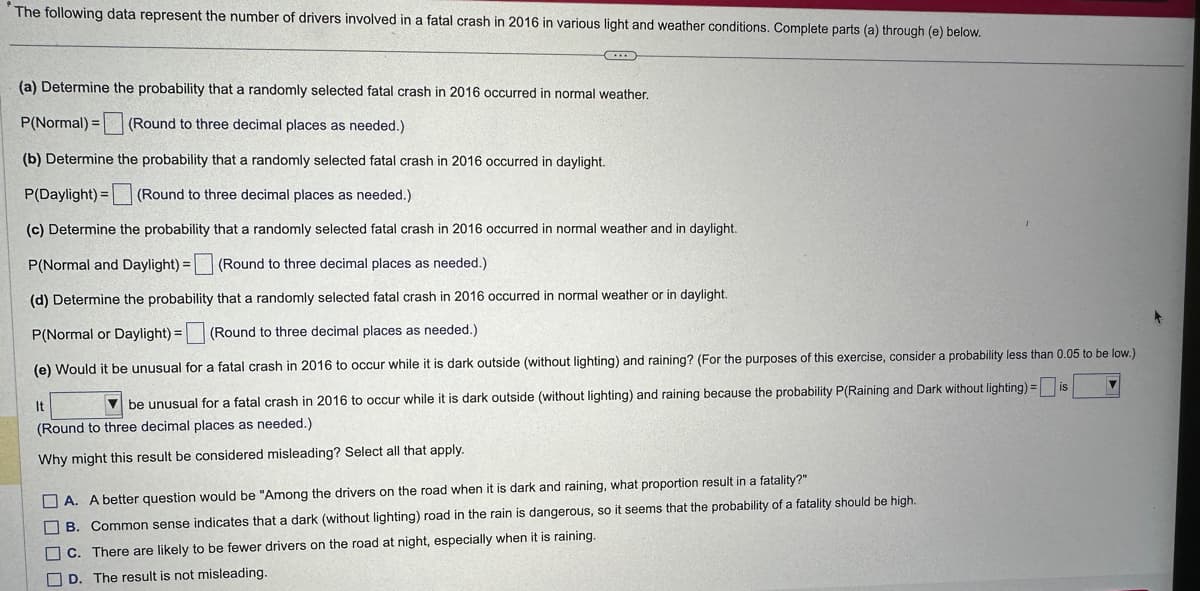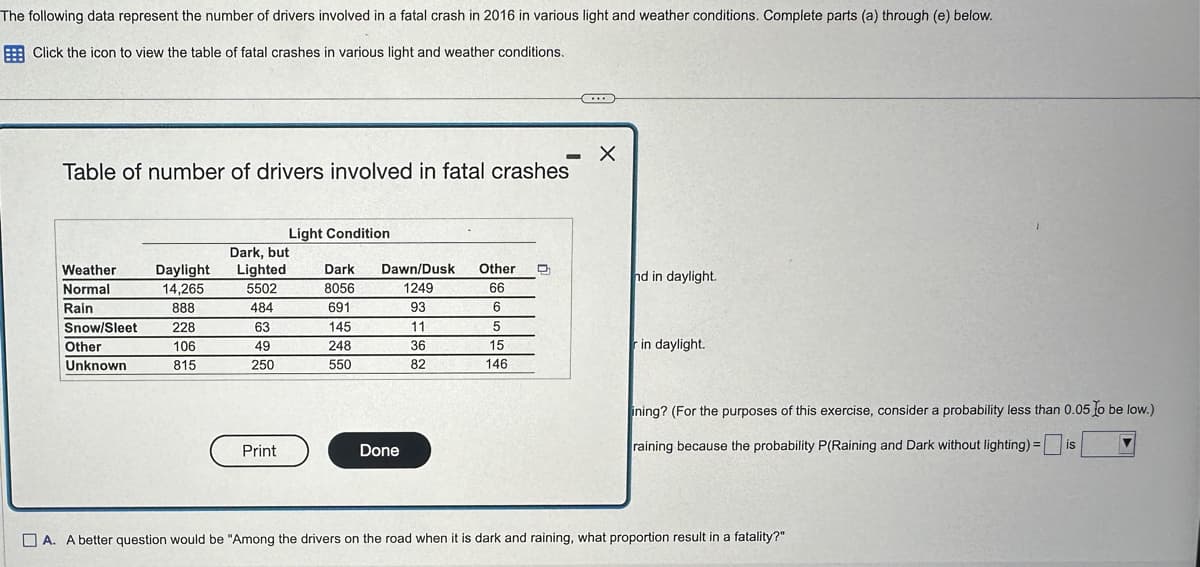The following data represent the number of drivers involved in a fatal crash in 2016 in various light and weather conditions. Complete parts (a) through (e) below. (a) Determine the probability that a randomly selected fatal crash in 2016 occurred in normal weather. P(Normal) = (Round to three decimal places as needed.) (b) Determine the probability that a randomly selected fatal crash in 2016 occurred in daylight. P(Daylight) = (Round to three decimal places as needed.) (c) Determine the probability that a randomly selected fatal crash in 2016 occurred in normal weather and in daylight. P(Normal and Daylight) = (Round to three decimal places as needed.) (d) Determine the probability that a randomly selected fatal crash in 2016 occurred in normal weather or in daylight. P(Normal or Daylight) = (Round to three decimal places as needed.) (e) Would it be unusual for a fatal crash in 2016 to occur while it is dark outside (without lighting) and raining? (For the purposes of this exercise, consider a probability less than 0.05 to be low.) It be unusual for a fatal crash in 2016 to occur while it is dark outside (without lighting) and raining because the probability P(Raining and Dark without lighting) = (Round to three decimal places as needed.) Why might this result be considered misleading? Select all that apply. A. A better question would be "Among the drivers on the road when it is dark and raining, what proportion result in a fatality?" B. Common sense indicates that a dark (without lighting) road in the rain is dangerous, so it seems that the probability of a fatality should be high. C. There are likely to be fewer drivers on the road at night, especially when it is raining. D. The result is not misleading.
The following data represent the number of drivers involved in a fatal crash in 2016 in various light and weather conditions. Complete parts (a) through (e) below. (a) Determine the probability that a randomly selected fatal crash in 2016 occurred in normal weather. P(Normal) = (Round to three decimal places as needed.) (b) Determine the probability that a randomly selected fatal crash in 2016 occurred in daylight. P(Daylight) = (Round to three decimal places as needed.) (c) Determine the probability that a randomly selected fatal crash in 2016 occurred in normal weather and in daylight. P(Normal and Daylight) = (Round to three decimal places as needed.) (d) Determine the probability that a randomly selected fatal crash in 2016 occurred in normal weather or in daylight. P(Normal or Daylight) = (Round to three decimal places as needed.) (e) Would it be unusual for a fatal crash in 2016 to occur while it is dark outside (without lighting) and raining? (For the purposes of this exercise, consider a probability less than 0.05 to be low.) It be unusual for a fatal crash in 2016 to occur while it is dark outside (without lighting) and raining because the probability P(Raining and Dark without lighting) = (Round to three decimal places as needed.) Why might this result be considered misleading? Select all that apply. A. A better question would be "Among the drivers on the road when it is dark and raining, what proportion result in a fatality?" B. Common sense indicates that a dark (without lighting) road in the rain is dangerous, so it seems that the probability of a fatality should be high. C. There are likely to be fewer drivers on the road at night, especially when it is raining. D. The result is not misleading.
Glencoe Algebra 1, Student Edition, 9780079039897, 0079039898, 2018
18th Edition
ISBN:9780079039897
Author:Carter
Publisher:Carter
Chapter10: Statistics
Section10.6: Summarizing Categorical Data
Problem 25PPS
Related questions
Question
i just need help solving d, e, and f please. thanks

Transcribed Image Text:The following data represent the number of drivers involved in a fatal crash in 2016 in various light and weather conditions. Complete parts (a) through (e) below.
(a) Determine the probability that a randomly selected fatal crash in 2016 occurred in normal weather.
P(Normal) = (Round to three decimal places as needed.)
(b) Determine the probability that a randomly selected fatal crash in 2016 occurred in daylight.
P(Daylight) = (Round to three decimal places as needed.)
(c) Determine the probability that a randomly selected fatal crash in 2016 occurred in normal weather and in daylight.
P(Normal and Daylight) = (Round to three decimal places as needed.)
(d) Determine the probability that a randomly selected fatal crash in 2016 occurred in normal weather or in daylight.
P(Normal or Daylight) = (Round to three decimal places as needed.)
(e) Would it be unusual for a fatal crash in 2016 to occur while it is dark outside (without lighting) and raining? (For the purposes of this exercise, consider a probability less than 0.05 to be low.)
is
It
be unusual for a fatal crash in 2016 to occur while it is dark outside (without lighting) and raining because the probability P(Raining and Dark without lighting) =
(Round to three decimal places as needed.)
Why might this result be considered misleading? Select all that apply.
A. A better question would be "Among the drivers on the road when it is dark and raining, what proportion result in a fatality?"
B. Common sense indicates that a dark (without lighting) road in the rain is dangerous, so it seems that the probability of a fatality should be high.
C. There are likely to be fewer drivers on the road at night, especially when it is raining.
D. The result is not misleading.

Transcribed Image Text:The following data represent the number of drivers involved in a fatal crash in 2016 in various light and weather conditions. Complete parts (a) through (e) below.
Click the icon to view the table of fatal crashes in various light and weather conditions.
Table of number of drivers involved in fatal crashes
Weather
Normal
Rain
Snow/Sleet
Other
Unknown
Dark, but
Daylight Lighted
14,265
888
5502
484
228
106
815
63
49
250
Light Condition
Print
Dark
8056
691
145
248
550
Dawn/Dusk Other D
1249
66
93
6
11
5
36
15
82
146
-
Done
X
nd in daylight.
in daylight.
ining? (For the purposes of this exercise, consider a probability less than 0.05 To be low.)
raining because the probability P(Raining and Dark without lighting) =is
A. A better question would be "Among the drivers on the road when it is dark and raining, what proportion result in a fatality?"
▼
Expert Solution
This question has been solved!
Explore an expertly crafted, step-by-step solution for a thorough understanding of key concepts.
This is a popular solution!
Trending now
This is a popular solution!
Step by step
Solved in 2 steps with 2 images

Recommended textbooks for you

Glencoe Algebra 1, Student Edition, 9780079039897…
Algebra
ISBN:
9780079039897
Author:
Carter
Publisher:
McGraw Hill

Holt Mcdougal Larson Pre-algebra: Student Edition…
Algebra
ISBN:
9780547587776
Author:
HOLT MCDOUGAL
Publisher:
HOLT MCDOUGAL

Algebra: Structure And Method, Book 1
Algebra
ISBN:
9780395977224
Author:
Richard G. Brown, Mary P. Dolciani, Robert H. Sorgenfrey, William L. Cole
Publisher:
McDougal Littell

Glencoe Algebra 1, Student Edition, 9780079039897…
Algebra
ISBN:
9780079039897
Author:
Carter
Publisher:
McGraw Hill

Holt Mcdougal Larson Pre-algebra: Student Edition…
Algebra
ISBN:
9780547587776
Author:
HOLT MCDOUGAL
Publisher:
HOLT MCDOUGAL

Algebra: Structure And Method, Book 1
Algebra
ISBN:
9780395977224
Author:
Richard G. Brown, Mary P. Dolciani, Robert H. Sorgenfrey, William L. Cole
Publisher:
McDougal Littell